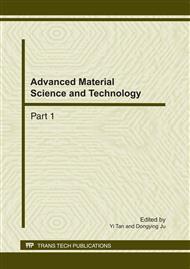p.239
p.243
p.247
p.251
p.255
p.259
p.263
p.267
p.271
Preparation and Morphological Characteristics of Cellulose Micro/Nano Fibrils
Abstract:
Cellulose micro/nano fibrils generated from biomass are relative new reinforcing materials for polymer composites, which have potential lightweight and high strength and are renewable. In the present study, the preparation method of extracting cellulose micro/nano fibrils from wood was introduced. After successful disintegration, the morphological characteristics of the wood fibers, purified cellulose fibers, cellulose fibers activated by ultrasonic-wave and cellulose micro/nano fibrils after homogenization treatment, were compared by visual examination and scanning electron microscopy. The results showed that cellulose micro/nano fibrils have been efficiently extracted from wood, which have great potential in the application areas of papermaking, bio-nanocomposites, food, cosmetics/skin cream, medical/pharmaceutical, and so on.
Info:
Periodical:
Pages:
255-258
Citation:
Online since:
February 2011
Authors:
Price:
Сopyright:
© 2011 Trans Tech Publications Ltd. All Rights Reserved
Share:
Citation:


